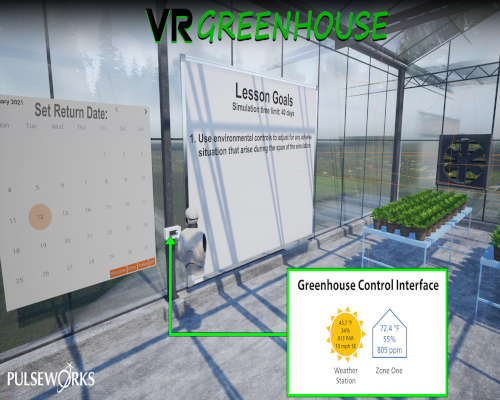Learning how to maneuver the high-risk aspects of the agriculture industry is taking on a new meaning for Mississippi State students through 3-D virtual reality and the university’s Future Growers Technology Initiative.

A one-of-a-kind simulated greenhouse, nearing completion and developed through the initiative’s cross-college collaboration efforts, not only will give future farmers a safer state-of-the-art tool, but will redefine the time it takes to analyze crop production. The project is a partnership of MSU’s Department of Plant and Soil Sciences in the College of Agriculture and Life Sciences and the Center for Advanced Vehicular Systems.
Funded through a federal grant, the principal investigator is Amelia Fox, clinical professor in plant and soil sciences, who said that unlike any conventional greenhouse on campus, this controlled condition system in 3-D will give students complete access to helm the environmental controls.
“With virtual reality, we can tackle teaching high risk agricultural enterprise, defined as anything that could result in significant loss—from loss of life or limb to loss of production, equipment or supplies. From how to control a greenhouse or poultry house to how to operate a tractor, virtual reality can help students learn to navigate high risk situations safely,” Fox said. “We want students to have access to failure. The more knowledgeable you become about failure, the more likely you can avert it.”
Fox said the COVID-19 pandemic has further demonstrated the need for this type of technology.
“One silver lining of the COVID-19 pandemic is that it’s shown us how technology can enhance face-to-face learning, which has limitations,” Fox said.
Daniel Carruth, associate research professor at CAVS, said the team approached the prototype in three parts, modeling the greenhouse itself with temperature, water and nutrient settings first before developing the control panel and user interface.
“The goal of virtual reality is to give students access to something they wouldn’t necessarily have access to in a faster way. With this system, students can now complete crop planting, growth and harvest within hours compared to the months it takes in the real world.”
The team’s prototype is now being refined by Pulseworks, LLC, a world leader in motion simulators. Next, Richard Harkess, a professor of plant and soil sciences, will use the technology in his greenhouse crops production course, hopefully by this coming fall semester.
Students will grow spinach, lettuce and tomatoes in a virtual greenhouse from seed to market, setting up environmental controls and then checking on, feeding and watering their crops, while troubleshooting insect and disease pressure and more. The team also will test the efficacy of the system by measuring how much the students learn from it.
Harkess said the technology uniquely positions students to garner hands-on experience manipulating greenhouse controls, something they haven’t had access to up to this point.
“Even in a college setting, students don’t gain access to the controls in a conventional greenhouse because one small mistake can kill a large number of plants. In a commercial environment, the stakes are even higher with the potential to lose tens of thousands of dollars in a production environment if crop damage occurs,” Harkess said. “While each of my students grows a crop from seed to market in a conventional greenhouse setting, everything they learn about the control system has been theoretical until now.”
Harkess said access to real-world consequences in a virtual environment is what excites him most about the technology.
“Students will be able to learn the ins and outs of the environmental controls including lighting, cooling, heating, shading and more. Developing this advanced skillset in turn helps them grow professionally, advancing faster in the workforce,” he said. “The possibility of putting our students in a situation where they’re in charge of a greenhouse growing multiple crops gives them a real sense of what they’ll be doing once they’re out in the field working in a production environment.”
The project is funded by a three-year USDA National Institute of Food and Agriculture grant, which runs through July 2022 and is from the organization’s Food and Agriculture Cyberinformatics and Tools (FACT) initiative.
Collaborators include Christopher Hudson, a CAVS research engineer implementing the temperature and plant growth models for the virtual greenhouse, and Shuchisnigdha Deb of the University of Texas at Arlington, who is working with MSU investigators to assess the design and application of the virtual greenhouse in the classroom. In addition to Pulseworks, industry partners include Wadsworth Control Systems, which develops greenhouse automation systems, including climate controls, curtain systems and vent automation and Chore-Time, a division of Chore Time Brock, a leading global designer, manufacturer and marketer of agricultural systems and solutions.
Source : msstate.edu